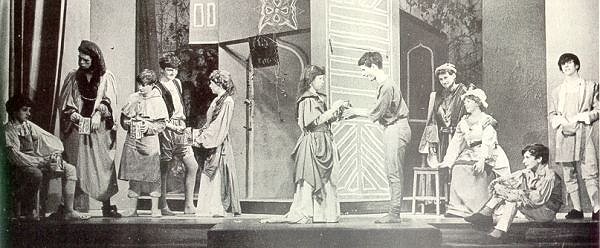

Review in the 1966 Summer Soham Grammarian
Dekker's warm and vigorous comedy of London life made an excellent choice for the School Play at the end of the Autumn Term. Its characters may lack the depth and range of Shakespeare's incomparable gallery, but they were given tremendous life by a large and enthusiastic team of schoolboy actors. Two performances above all held the play together: Moll's energetic large-scale Simon Eyre, relishing every extravagant Elizabethan insult in this whale of a part; and Green's impudent Firk, bustling at the head of his fellow apprentices and always in lively contact with his audience. Eyre's shop was full of interesting and credible people: Newton's Margery had the vocal and physical weight to balance Moll, while quieter sketches were subtly filled in by Sandham as witty Hodge and Malkin as honest Ralph.
The play's romantic scenes contrast nicely with the broader humours of Tower Street. Thornhill made a pretty Rose; he and Giles (Jane) spoke Dekker's verse unaffectedly and well, while Covell's sense of mischief produced a neat Sybil. Brown's delicate study of the affected Hammon made an effective foil for Bent's dashing hero he managed his Dutch disguise well.
Older men are not always easy to cast convincingly; as the Lord Mayor, Quicke was a striking blend of Shylock and Barrett (of Wimpole Street): Parkinson had a good line in aristocratic tantrums; and Dunham played the King with dignity. Maximum effect in small parts was achieved by Wood - an oily Dodger, and Webster - an effete looker-on at Court.
The stage was always effective to look at; transformation from crowded London street to country garden was achieved with the minimum of fuss - some evocative sound effects and attractive street signs helped enormously. Very successful, too, were the street interludes, devised by Mr O'Toole, with authentic street cries and songs of the period producing a fascinating blend of Merrie England and Dickensian low life entirely typical of this notable production This was the last play to be produced at Soham by Mr Hemmings; may the tradition be worthily maintained.
CAST IN ORDER OF APPEARANCE
Earl of Lincoln (Sir Hugh Lacy) - SC Parkinson
Lord Mayor of London (Sir Roger Oateley) - SE Quicke
Lovell - JR Harding
Rowland Lacy (otherwise Hans Meulter) - KC Bent
Askew - DM and TC Salmon
Simon Byre (The Shoemaker) - VAJ Moll
Margery, his wife - M Newton
Hodge his foreman - TJ Sandham
Firk his journeymen - BJ Green
Ralph his journeymen - JE Malkin
Jane, Ralph's wife - CJ Giles
Dodger, a spy - JO Wood
Rose, daughter to the Lord Mayor - M Thornhill
Sybil, her maid - LJBCovell
Citizens of London:
Hammon - JA Brown
Warner - PM Ellis
Scott - GD Audus
source: HaslamA Dutch Skipper - EB Crompton
Hammon's servant - SAC Gilbert
Earl of Cornwall - JA Webster
The King - RNR DunhamAPPRENTICES, SERVANTS, STREET-SELLERS:
DM Beale, AC Benson, RJ Brown, JW Carter, BK Coe, PAJ Easy, CW Fisher, SD Freeman, PN Goodfellow, AB Hills, SJ Lemmon, W Matthews, RC Mitchell, RC Myson, TT Pennick, JR Phillips, KTaylor and MF WilkinsSCENE: London and the Country nearby
The Play produced by Mr GE Hemmings
The street interludes devised by Mr JR O'TooleCOSTUMES: Mr PJ Askem
SET CONSTRUCTION, PAINTING AND STAGE MANAGEMENT: Mr RGS Bozeat, Mr JW Rennison, DA Anderson, AK Bailey, JH Bailey, PV Dunham, TC Ewer, PE Leslie, DJ Nicholas, SC Porter and RT Ward
LIGHTING: Mr RJH Makin, Mr PD Scott, GD Ferrnie, NV Grainger and PCT Whitmore
PROPERTIES: Mr CA Royal-Dawson, FW Haslam, AP Walker and TM Bartlett
MUSIC: Mr MJ Ades
PROMPTER: SJ Martin
BUSINESS MANAGEMENT: Mr LR Hart, Mr SR Saunders and Mr N SherringtonWe wish to acknowledge most sincerely all the other help, especially in make-up and costuming, given so willingly by boys, parents and friends.
There will be one interval of fifteen minutes during which coffee will be served
The Guild of Shoemakers - or the Worshipful Company of Cordwainers (so called from their use of Spanish Cordovan leather) - originated in the 13th century, and still operates today Shoemaking was known as the Gentle Craft, not because its apprentices were any less rowdy than other apprentices, but because it involved a good deal of gentlemanly sitting down Its patron saints were Saint Hugh and Saint Crispin, and its coat of arms depicts the goats which supplied much of the raw material used in the craft.
If you can add further recollections or photos, please contact the editor.
page last updated 9 Nov 2007